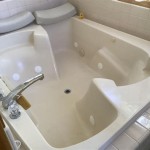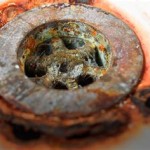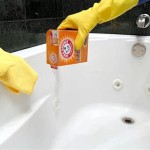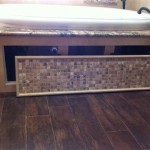Removing Rust Stains From Acrylic Bathtubs: A Comprehensive Guide
Acrylic bathtubs, prized for their durability, affordability, and ease of maintenance, can nonetheless fall victim to unsightly rust stains. These stains, typically caused by prolonged exposure to iron-rich water or the presence of metal objects in contact with the tub's surface, can significantly detract from the aesthetic appeal of a bathroom. Understanding the causes, the appropriate cleaning agents, and the correct techniques for removing rust stains is crucial for maintaining the pristine condition of an acrylic bathtub. This article provides a comprehensive guide to effectively and safely addressing rust stains on acrylic surfaces.
The source of the rust is a primary consideration when determining the best course of action. Hard water, which contains a high concentration of minerals, including iron, can leave deposits on the tub surface that oxidize over time, creating rust stains. Similarly, if metal objects, such as shaving cream cans or bath toys with metallic components, are left in the tub, they can corrode and leave rust stains directly on the acrylic. The type of stain, its age, and its severity will all influence the cleaning approach.
Understanding the Nature of Acrylic and Rust
Acrylic bathtubs are manufactured from a type of plastic called polymethyl methacrylate (PMMA). This material is known for being non-porous, which makes it relatively resistant to staining and easy to clean compared to other bathtub materials like porcelain or cast iron. However, acrylic is also relatively soft, which means it can be scratched or damaged by abrasive cleaners or harsh scrubbing. This vulnerability necessitates the use of gentle cleaning methods tailored for acrylic surfaces when dealing with rust stains.
Rust, chemically known as iron oxide, is the result of a chemical reaction between iron, oxygen, and water. It's a persistent stain that can penetrate the surface of materials if left untreated. On acrylic, rust manifests as a reddish-brown discoloration that can range from light and superficial to dark and deeply embedded. The longer the rust is allowed to remain on the acrylic, the more difficult it will be to remove. Therefore, early intervention is crucial for minimizing the damage and expediting the cleaning process.
It's important to distinguish between true rust stains and other types of discoloration that may appear similar. Soap scum, hard water deposits (other than iron), and mold can sometimes be misidentified as rust. Before attempting to remove a perceived rust stain, it's wise to test a small, inconspicuous area with a general-purpose bathroom cleaner to see if the discoloration is removed. If the discoloration persists, it is more likely to be a true rust stain that requires more specific treatment.
Safe and Effective Cleaning Solutions for Acrylic Bathtubs
When selecting a cleaning solution for removing rust stains from an acrylic bathtub, it is imperative to choose products that are specifically formulated for use on acrylic surfaces. Avoid abrasive cleaners, scouring pads, and harsh chemicals such as bleach, ammonia, or concentrated acids. These products can scratch, dull, and even permanently damage the acrylic, exacerbating the problem and potentially requiring costly repairs. The following cleaning solutions are generally considered safe and effective for removing rust stains from acrylic bathtubs:
Baking Soda Paste: Baking soda is a mild alkali that can effectively lift rust stains without damaging the acrylic. To create a baking soda paste, mix baking soda with a small amount of water until a thick paste is formed. Apply the paste to the rust stain, allow it to sit for 15-30 minutes, and then gently scrub with a soft cloth or sponge. Rinse thoroughly with water.
White Vinegar: White vinegar, a mild acid, is another safe and effective option for removing rust stains. Soak a clean cloth or sponge in white vinegar and apply it to the rust stain. Allow the vinegar to sit for several hours, or even overnight for stubborn stains. Then, gently scrub the area with the cloth or sponge and rinse thoroughly with water. For more stubborn stains, a vinegar-soaked cloth can be taped or held in place over the stain to maximize contact time.
Lemon Juice: Lemon juice, like vinegar, is a natural acid that can help dissolve rust. Apply lemon juice directly to the rust stain and allow it to sit for 30 minutes to an hour. Then, scrub the area with a soft cloth or sponge and rinse thoroughly with water. The citric acid in lemon juice helps to break down the rust and lift it from the acrylic surface.
Cream of Tartar: Cream of tartar, a mild abrasive, can be combined with lemon juice or hydrogen peroxide to create a cleaning paste. Mix cream of tartar with enough lemon juice or hydrogen peroxide to form a paste. Apply the paste to the rust stain, let it sit for 10-15 minutes, and then gently scrub with a soft cloth or sponge. Rinse thoroughly with water.
Commercial Rust Removers (Acrylic-Safe): Several commercial rust removers are specifically formulated for use on acrylic surfaces. When using a commercial rust remover, it is crucial to read and follow the manufacturer's instructions carefully. Always test the product in a small, inconspicuous area first to ensure that it does not damage the acrylic. Choose a non-abrasive formula and apply it with a soft cloth or sponge.
Hydrogen Peroxide: Hydrogen peroxide is a mild bleaching agent that can help to lighten rust stains. Apply hydrogen peroxide directly to the rust stain and let it sit for several hours. Then, scrub the area with a soft cloth or sponge and rinse thoroughly with water. Hydrogen peroxide is particularly effective for removing lighter rust stains.
Step-by-Step Rust Stain Removal Procedure
Regardless of the cleaning solution chosen, the process for removing rust stains from an acrylic bathtub generally follows these steps:
Preparation: Before beginning, gather all necessary supplies, including the chosen cleaning solution, soft cloths or sponges, a spray bottle (optional), and water for rinsing. Ensure the bathroom is well-ventilated.
Testing: Test the cleaning solution in a small, inconspicuous area of the bathtub to ensure that it does not damage the acrylic. Allow the solution to sit for the recommended time, then rinse and check for any discoloration or damage.
Application: Apply the cleaning solution to the rust stain, ensuring that the entire affected area is covered. For liquids, a spray bottle can be helpful for even distribution. For pastes, apply a generous amount to the stain.
Soaking/Dwelling Time: Allow the cleaning solution to sit on the rust stain for the recommended time. This allows the solution to penetrate the rust and begin to break it down. The exact dwell time will vary depending on the cleaning solution and the severity of the stain.
Scrubbing: Gently scrub the rust stain with a soft cloth or sponge. Avoid using abrasive scrub pads or brushes, as these can scratch the acrylic. Apply light to moderate pressure, focusing on the stained area. Circular motions are often effective for lifting the rust.
Rinsing: Rinse the area thoroughly with water to remove all traces of the cleaning solution and loosened rust. Ensure that no residue remains on the acrylic surface.
Drying: Dry the area with a clean, soft cloth. This will help to prevent water spots and further staining.
Repeat (If Necessary): If the rust stain is particularly stubborn, repeat steps 3-6 as needed. Multiple applications of the cleaning solution may be required to completely remove the stain. Avoid prolonged or aggressive scrubbing, as this can damage the acrylic.
For particularly severe rust stains, a combination of cleaning solutions and techniques may be necessary. For instance, a baking soda paste can be applied after a vinegar soak to provide both chemical and mild abrasive action.
Prevention is always better than cure. Implementing strategies to prevent rust stains from forming in the first place can significantly reduce the need for aggressive cleaning measures. Consider the following preventative measures:
Addressing the Water Source: If hard water is the primary cause of rust stains, consider installing a water softener to reduce the iron content of the water. This will not only prevent rust stains in the bathtub but also protect other plumbing fixtures and appliances in the home.
Removing Metal Objects: Avoid leaving metal objects, such as shaving cream cans, bath toys, or cleaning supplies with metal components, in the bathtub. Store these items in a separate location to prevent them from corroding and leaving rust stains on the acrylic surface.
Regular Cleaning: Regularly clean the bathtub with a mild, non-abrasive cleaner to remove any mineral deposits or soap scum that could contribute to rust formation. A weekly cleaning routine can help to prevent stains from building up and becoming more difficult to remove.
Drying the Tub: After each use, dry the bathtub with a clean towel to remove excess water and prevent mineral deposits from forming. This simple step can significantly reduce the likelihood of rust stains and other types of discoloration.
By understanding the nature of rust stains, selecting appropriate cleaning solutions, employing correct techniques, and implementing preventative measures, maintaining the pristine condition of an acrylic bathtub can be achieved.

Ask Me Anything Rust Stains He Washer Stained Concrete More Everyday Skate

Clean With Me Removing Rust Stains From A Bathtub And Marble Best Cleaning Ever

Fast And Non Toxic Way To Remove Rust Stains Out Of Acrylic Bathtub

How Do I Clean Out Rust From Acrylic Tubs Hometalk

Clean With Me Removing Rust Stains From A Bathtub And Marble Best Cleaning Ever

3 Easy Ways To Remove Rust From A Bathtub Wikihow

How Do You Get Rust Stains Out Of A Plastic Tub Hometalk

How To Remove Rust Stains In A Tub Without Chemicals Get Green Be Well

Learn How To Remove Bathtub Stains Rooterman

Effective Methods On How To Remove Rust Stains From Your Bathtub Ft Worth Refinishing








